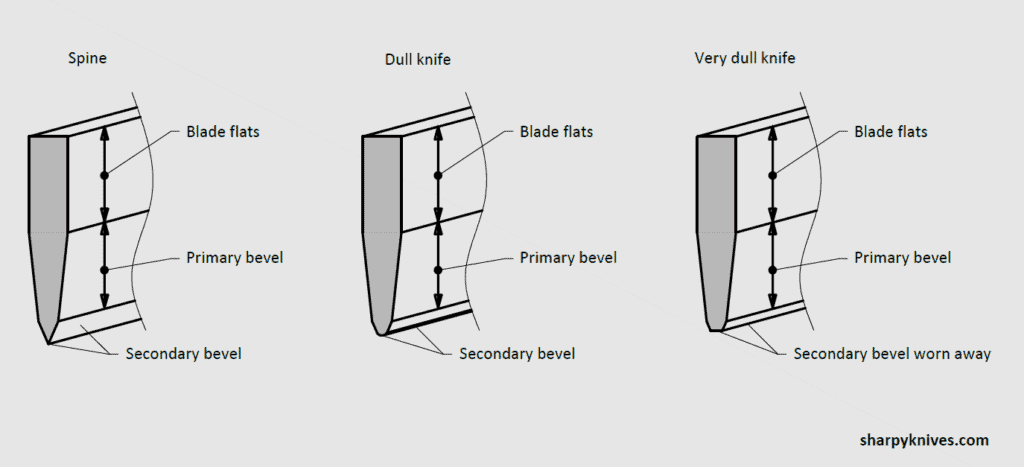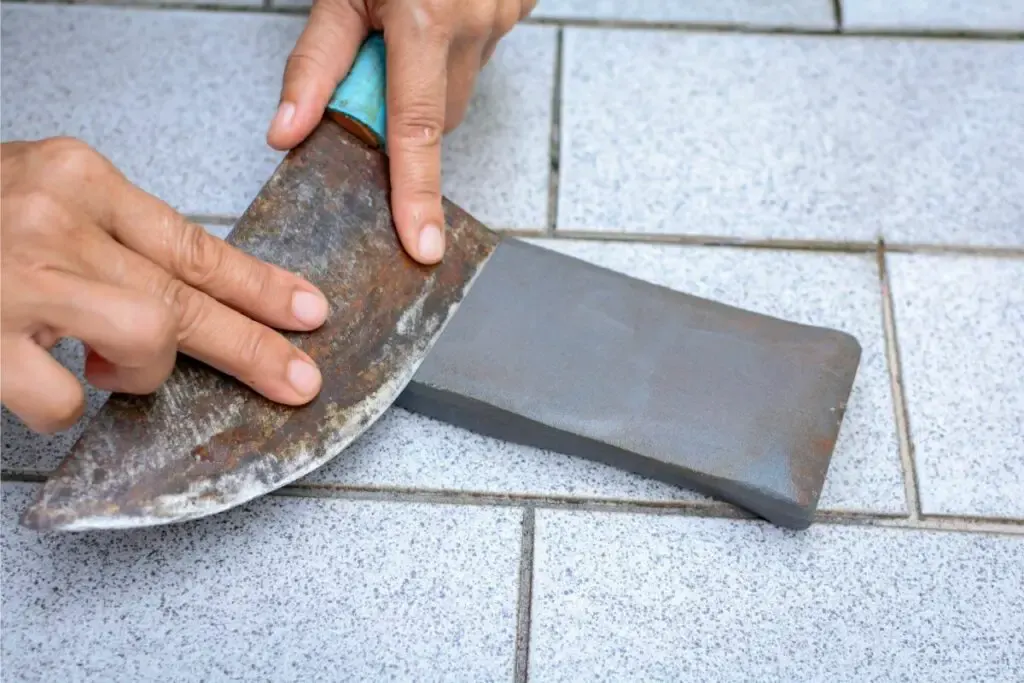As an Amazon Associate, we earn from qualifying purchases with no additional costs for you.
We all know that knives are meant to be sharp and that a dull knife is said to be more dangerous to use than a sharp one. This means that a dull knife needs to have its edge kept as sharp as possible. At some point, kitchen-style knife sharpeners can no longer sharpen a knife. Does this mean that the knife has become too dull to be sharpened, or can the knife be salvaged?
A knife can be too dull to be sharpened with a kitchen knife sharpener. In this case, the knife will need to be re-profiled to re-establish the secondary bevel at the cutting edge of the blade. With the secondary bevel re-established, the knife will be able to be sharpened again.
If a knife no longer sharpens on a kitchen knife sharpener, you may come to the conclusion that the knife is too dull to take an edge and it cannot be sharpened again. This is not correct thinking, however, and is simply a lack of understanding of knife edge geometry and what knife sharpeners do.
If you are interested in checking out the best whetstones for sharpening your knives we recommend and use you can find them by clicking here (Amazon link).
Can A Knife Be Too Dull To Re-sharpen?

Many of the knife sharpeners that are used in the kitchen to sharpen a knife are not really knife sharpeners but would more correctly be called knife edge honers.
To understand why this is more accurate, we need to examine the edge geometry of a knife and explain some of the terminologies around knife blades.
The blade profile slopes from the top edge or spine of the knife towards the sharp edge of the knife and this are called the primary bevel of the knife.
The actual cutting edge of the knife, in most styles of knives, but not all, requires a secondary bevel to get the edge of the blade to the point of being sharp and functional.
Most kitchen-style knife sharpeners do not sharpen the knife by creating the secondary bevel but rather hone the secondary bevel to re-establish the sharp cutting edge. Their material removal ability on the edge of the knife is usually quite limited.

If the secondary bevel of the knife blade has worn down to the point that it almost intersects the primary bevel, the edge is too thick for a kitchen knife sharpener to re-establish the secondary bevel and thus sharpen the knife.
The kitchen-style knife sharpener simply does not have enough cutting power or ability to be able to remove enough steel to re-establish the secondary bevel and refine this bevel down to a sharp cutting edge.
So, what can you do in an effort to restore the edge on a knife that has become this dull? Is it a lost cause and a candidate for the trash, or can the knife be salvaged?
How To Save A Very Dull Knife
The only course of action to be able to save an extremely dull knife is to re-profile the blade and re-establish the secondary bevel.
If the knife is very blunt, the re-profiling may have to be fairly drastic and involve quite a lot of adjustment to the blade.
This may result in the blade being slightly smaller after the re-profiling than its original size to get the proportions of the two bevels to be correct for the style of the knife.
Thus, the profile of the knife will need to be re-shaped since the height of the knife blade has become shorter by the secondary bevel being worn away.
This will normally require some specialized knifemaking tools, although it can be done with a file and some sandpaper if you have a good eye and a lot of patience!
Sometimes, in a really bad case, the primary bevel needs to be re-shaped to a narrower angle for the purpose of getting the angle of the bevels correct for the secondary bevel.
In most instances, however, the secondary bevel can simply be ground back into the blade using a belt grinder or other similar abrasive tool that will allow you to remove a good amount of material from the blade in a short space of time.
A belt grinder is one of the best tools for knife sharpening and can be used to rapidly re-profile or sharpen a blade before honing.
If you do not have a belt grinder, you can perform this task on a set of whetstones, starting at a coarse grit and working your way up to finer and finer grits.
However, most knife makers don’t want to do this because it creates heavy wear on their expensive sharpening stones. It also takes a long time to do this task with whetstones, requiring accuracy of angles, a steady hand, and patience throughout the process.
This will be a rough grind that will re-shape the secondary bevel to the point of getting an apex on the very tip of the secondary bevel.
This has re-established the secondary bevel and the edge, but the knife will still not be sharp. The edge will need to be shaped further to get a final sharp edge.
Tip: If you try to sharpen a knife that is too dull, it can easily happen that this knife will eventually be over-sharpened. But is it even possible to over-sharpen an knife? Find out more in the article below:
Can You Oversharpen A Knife? All You Need To Know
Refining The Edge Of A Dull Knife
Once the secondary bevel has been re-established, the edge needs to be refined to the point of creating a burr or a wire edge at the very apex of the secondary bevel. This requires specialized knife-sharpening techniques that take time to master.
This can be done with higher grit whetstones, which will remove smaller amounts of material and will refine the edge and produce the burr.
Once the burr has been established, the next step is to hone the edge. This will produce a razor-sharp edge and leave the knife in a sharp, usable condition.
The honing can be done on a leather strop with or without some fine jeweler’s rouge on the strop. This process will remove the burr or the wire from the edge and will polish the secondary bevel, and make it extremely sharp.
Once the knife has been reconditioned to this point, it can be used again for its intended purpose, and you can once again use kitchen-style sharpeners to hone the cutting edge every now and again.
How Often Can A Dull Knife Be Re-profiled?

A knife has a finite amount of steel in the body of the blade. The process of re-profiling a knife removes steel from the blade and changes the dimensions of the knife.
Obviously, at some point, the knife will have lost a significant amount of steel, and it will no longer be usable for the purpose for which it was intended.
This still does not mean that the knife has reached the end of its useful life; it may just have reached the end of its life in a particular role.
For example, a chefs’ knife that has become worn down to the point of no longer functioning as a chefs’ knife can be re-shaped and repurposed in the role of a paring knife, which is a smaller knife.
This process would require some knifemaking skills, and the cost to do this often does not warrant the effort. It would probably just be cheaper to toss the old chefs’ knife and purchase another one and get a new paring knife at the same time.
TIP: Many people think that sharpening a knife removes metal from the knife during this process. Check out the main factors that affect it in the article below:
Does Sharpening A Knife Remove Metal from It? Main Factors
Knife Sharpening FAQ
Many people new to knife sharpening are uncertain how to sharpen a dull knife. Knife sharpening requires learning the correct knife sharpening techniques and using the best knife sharpening tools. The following questions are some frequent queries we get from people starting their knife sharpening journey.
1. What’s the difference between honing and sharpening a knife?
Honing a knife aligns the edge of the blade without removing any material, while sharpening a knife involves grinding away material to create a new, sharp edge.
2. Can a knife be too dull to sharpen?
No, a knife can never be too dull to sharpen. However, if a knife is extremely dull, it may need to be re-profiled, which is a more extensive process than simple sharpening.
3. What tools do I need to sharpen a knife?
Basic knife sharpening can be done with a sharpening stone or a honing rod. For more extensive re-profiling, you might need a belt grinder or similar abrasive tool.
4. How often should I sharpen my knife?
The frequency of sharpening depends on how often you use your knife and what you use it for. As a general rule, you should sharpen your knife whenever it starts to feel dull.
5. Can I repurpose my old, dull knives?
Yes, old knives can often be repurposed. For example, a chef’s knife that has become too small from repeated sharpening could be reshaped into a paring knife.
6. Does sharpening a knife shorten its lifespan?
Sharpening a knife does remove some material from the blade, which can eventually lead to the knife becoming too small for its intended purpose. However, regular sharpening is necessary to keep a knife functional and safe to use.
7. Can I oversharpen my knife?
Yes, it’s possible to oversharpen a knife if you remove too much material from the blade. This is more likely to happen if you’re using a powered sharpening tool. It’s important to use a light touch and check your progress frequently when sharpening a knife.
8. Do I need to sharpen a brand new knife?
Most new knives come pre-sharpened from the factory and are ready to use. However, some people prefer to give their new knives an extra sharpening to ensure they’re as sharp as possible.
Conclusion
An extremely dull knife is a challenge to re-sharpen and gets to the point of being usable again. However, a knife is never too dull to be sharpened.
The only time a knife would be too dull to be sharpened is if you only have basic edge honing tools at your disposal for sharpening your knife.
Having a set of whetstones will allow you to touch up the secondary bevel and re-establish a sharp cutting edge on the knife.
This process takes a little skill and patience, but it is definitely achievable and will allow you to save your favorite knife from the trash can!
Having some more advanced tools available will allow you to get the edge back on your knife much quicker, and then you can hone the edge to razor sharpness with a strop.
So, when your favorite knife can no longer be sharpened by a honing device, it is not a lost cause, but with a little love and careful attention, it can be restored to its former slicing and dicing glory!
TIP: A knife needs to have a good edge to be functional and to allow it to function for its intended use. So it is necessary to sharpen a new knife? Find out the answer in the article below:
Do You Need To Sharpen A Brand New Knife? Here’s The Answer!
